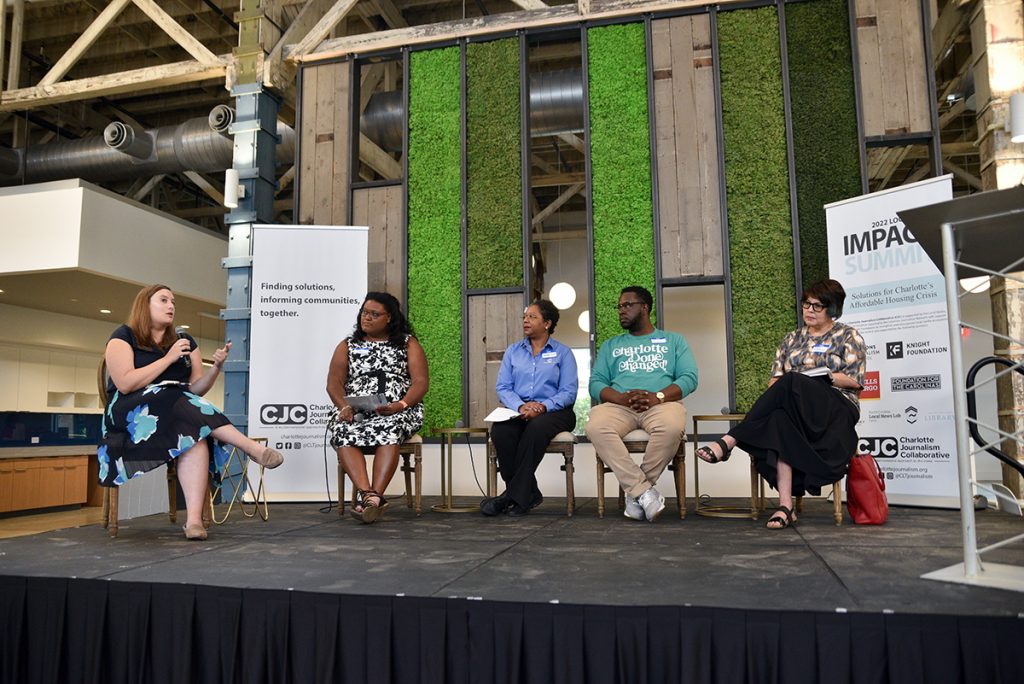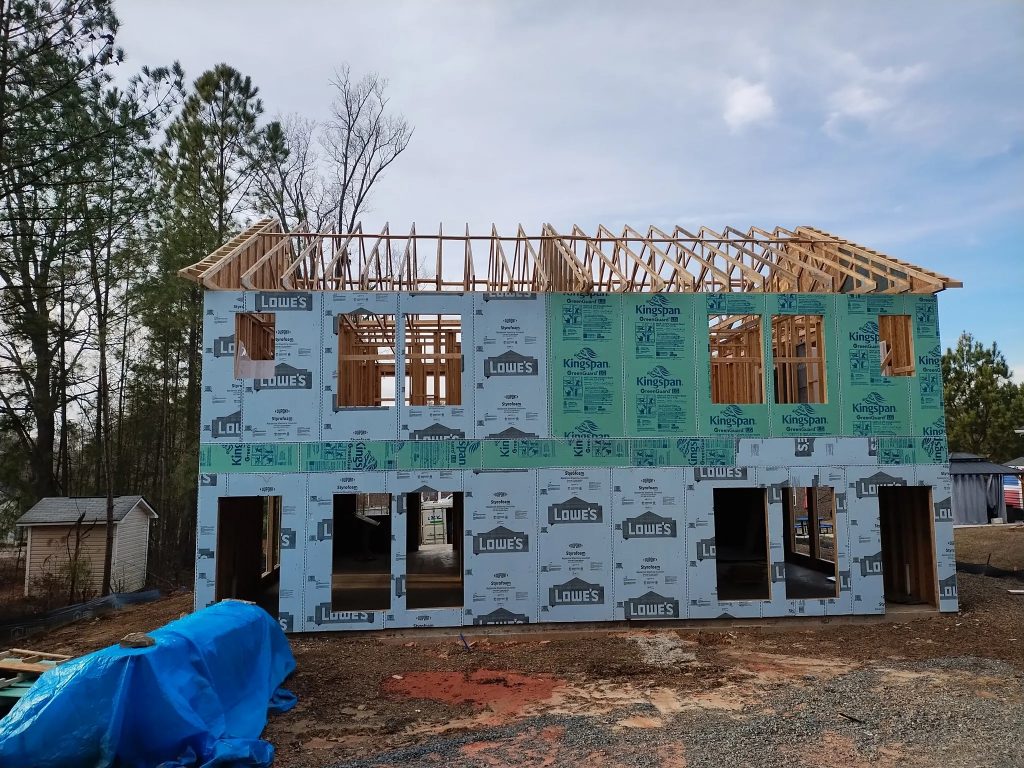Editor’s note from The Charlotte Observer: Lauren Lindstrom covered affordable housing for three years as a Report for America fellow with The Charlotte Observer. As her fellowship ends, she reflects on covering one of Charlotte’s biggest crises.
It’s remarkable but not at all surprising that my time reporting on affordable housing and homelessness began and ended with a mass displacement of vulnerable Charlotteans.
They are sobering bookends to my three-year chapter here. I’ve lost count of how many community meetings I’ve attended, introducing myself to people about to be forced out of their homes.
The neighborhoods and circumstances leading to removals change, but a pattern is evident.
Those displaced are almost always members of a marginalized community. Many are Black or Latino; low-income, elderly or disabled. So many are families with young children.
Tenants are almost all on month-to-month leases, a common practice for low-income renters that provides essentially no notice or protection from spontaneous displacement. Most stories begin with a letter in the mailbox or on the front door announcing that their world is about to be turned upside down.
Displacement has been a through line covering Charlotte’s housing crisis, where I tried hard to demystify complicated policies and amplify stories of residents caught in the tide of development, rising housing costs and gentrification.
Even as Charlotte invests millions to build and preserve affordable housing, and Mecklenburg County overhauls its strategy to address homelessness, these displacements continue largely unfettered.
A GROWING TALLY
My introduction to mass displacement was at Lake Arbor, the notoriously hazardous apartments off Tuckaseegee Road where tenants had raised alarms for years about unsafe wiring, water damage and pest infestations.
It was summer 2019, just a few weeks after I’d started at The Charlotte Observer. One muggy afternoon letters appeared on residents’ doors with orders to vacate, some within 30 days. The abrupt news came months after code enforcement officers found hundreds of violations at the nearly 300-unit complex, many of which the owners appealed.
I met bewildered seniors who struggled to think about going out to hunt for apartments with their fixed income and mobility struggles, and parents worried about how to explain it to their young children.
“I’m not putting my kids in the street,” one Lake Arbor resident told me the day after the notices appeared. He worried about finding an affordable place big enough for his five children. “They’ve got to give me some time. You can’t do it overnight.”
Organizations like United Way of Central Carolinas stepped up to raise money and help with relocation, but many residents still lacked permanent affordable housing for months after.
“It’s a cycle of displacement. There is nowhere to go,” tenant organizer Jessica Moreno told me that first summer. We’d have a nearly identical conversation nearly three years later about another community.
Watching people struggle set the tone for the rest of my coverage. Our conversations were both deeply personal and yet eerily similar.
I began speaking to residents of Countrywoods Mobile Home Park last winter. Just weeks ago I met neighbors in the Sterling neighborhood, where developers had purchased the communities and refused to renew residents’ month-to-month leases.
Residents in both communities told me that they liked the quiet neighborhoods, knew their neighbors and paid rents that were much more affordable than the surrounding areas. Properties like these are alluring to developers with plans to build something with a much higher return on investment.
Lake Arbor sold to a New York-based real estate investment firm for $14 million and was renovated, now operating as Nova Ridge. Countrywoods sold for $1.7 million to a Raleigh firm with ties to a New York investor in mobile home parks. The two dozen mobile homes will be demolished in favor of newer, more expensive replacements.
The Sterling homes buyer is a company connected to the luxury townhouses going up next to them. Some homes are already torn down, now vacant lots a harbinger of what’s to come. New construction is underway.
Longtime residents in these situations are often collateral damage, left to find another home in a city where the number of affordable units are scarce and shrinking.
“There’s nowhere in Charlotte — absolutely nowhere — that I can afford to live and be able to make it,” said one Sterling resident forced out along with her 9-year-old-granddaughter, possibly to a shelter. “If you had any type of compassion you would have informed us. Then we would have more time to prepare.”
I grew familiar with seeing the detritus of lives left behind. Furniture, children’s toys and other belongings sat at the curb and filled dumpsters from people without the time, space or money to move them.
Many displaced residents double up with family and friends or move into motels.
Once you move into a motel it’s nearly impossible to get out, residents and advocates have told me. While the upfront cost is less — no security deposit, credit check or application fee required — weekly payments often add up to exceed a month’s rent. That leaves little to save for the steep upfront costs to sign a lease.
County officials previously said there is no good estimate of how many Mecklenburg residents live in motels, which is the housing of last resort for far too many people.
But those motels are also the source of mass displacements. In the early months of the pandemic, I stood outside the Days Inn on Woodlawn Road, where management in June 2020 shut off water and power for more than 12 hours. It was the first of several moves to remove longtime residents, many of whom had fallen behind on payments.
In the time since I began writing this, another community joined the sobering tally. Around 200 residents of the extended Southern Comfort Inn, less than a mile from what used to be Lake Arbor, learned this week that they, too, need to be out in 30 days.
WHAT CAN BE DONE?
Displacement occurs in many ways, including through individual evictions, or when residents are priced out of neighborhoods by rent or property tax increases. But there’s something especially stark about the swift, large-scale events that sweep up dozens, sometimes hundreds of families at once.
In every community I visit, the same question arises: how can the next mass displacement be prevented?
The city-convened Neighborhood Equity and Stabilization Commission began meeting earlier this year and has begun work to study and recommend policies to address displacement.
Co-chair Justin Harlow, a former City Council member, said he expects the group’s recommendations to include finding a way to track the scale of the problem.
“How many people have been displaced from a place because of some event like an institutional buyer coming in and buying up a whole neighborhood?” he said. “We have not actually measured that before.”
Leslie Blaser, a spokeswoman for the city’s Housing and Neighborhood Services Department, said the commission’s charge will include looking at mass displacements specifically.
North Carolina law has restricted cities from implementing proposals that advocates say would ease the housing crisis such as inclusionary zoning to require developers to include affordable units in developments and rent control.
In Charlotte it has halted several proposed measures including source of income discrimination protections, which prevent landlords from automatically rejecting applicants because of the way they pay rent, such as a voucher.
Other states have enacted laws to address mass displacements. New York, California, Massachusetts are among those that have or are considering “opportunity to purchase” legislation to require owners of apartments or mobile home parks to give residents a chance to buy the property themselves. Others have laws requiring landlords to notify tenants when a building is for sale.
Substantial changes will almost certainly need some participation from the state.
Kathryn Firmin-Sellers, the local United Way’s chief impact officer, said it’s important to meet the specific needs of each displaced community without losing sight of systemic forces at work.
“Embrace the humanity, embrace the loss, the devastation that those families are facing,” she said. “But then let’s take a step back and realize that this is happening again, and again and again. Until we take a broad view of housing instability and homelessness, it will continue to recur.”
Leaders need to take a systemic approach to address all factors that lead to displacement, Firmin-Sellers said, including the economic instability that forces people into precarious living situations.
“You have to look at all of those things and ask ourselves why we as a city are unable to make sure that everyone who lives here has a home,” she said.
This story was originally published June 6, 2022 6:00 AM.




 The Charlotte Journalism Collaborative is supported by the Local Media Project, an initiative launched by the Solutions Journalism Network with support from the Knight Foundation to strengthen and reinvigorate local media ecosystems.
The Charlotte Journalism Collaborative is supported by the Local Media Project, an initiative launched by the Solutions Journalism Network with support from the Knight Foundation to strengthen and reinvigorate local media ecosystems.








